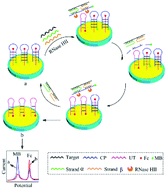A sensitive ratiometric electrochemical biosensor based on DNA four-way junction formation and enzyme-assisted recycling amplification
Abstract
A simple ratiometric electrochemical biosensor is developed for sensitive detection of target DNA based on DNA four-way junction (DNA-4WJ) formation and enzyme-assisted recycling amplification. This biosensor can be easily fabricated by a one-step assembly of ratiometric probes and simply performed by a one-step incubation procedure. In the presence of target DNA, two unmodified DNA oligonucleotides may cooperatively hybridize with a hairpin probe in the triple-helix molecular beacon (THMB) to form a DNA-4WJ, which may cause conformational transduction and induce the change in the distance between two redox labeling probes and the electrode surface. The subsequent recognition and cleavage of DNA-4WJ quadripartite complexes by RNase HII may result in significant signal amplification. Due to the introduction of DNA-4WJ formation, enzyme-assisted recycling amplification and ratiometric measurement, this biosensor exhibits high sensitivity with a detection limit as low as 0.063 pM and a long dynamic range from 0.1 pM to 100 nM. Moreover, this biosensor demonstrates good performance with excellent selectivity, high reliability and good reproducibility, holding great potential for further applications in biomedical research and clinical diagnostics.

- This article is part of the themed collection: Bioanalytical Sensors


 Please wait while we load your content...
Please wait while we load your content...